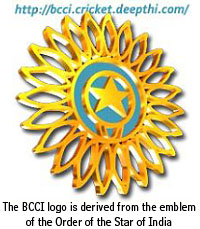

Board of Control for Cricket in India (BCCI)
Full ICC Member since 31 May 1926Latest BCCI News
BCCI is the apex governing body for cricket in India and lays down its law. Follow the links to find comprehensive news and information in BCCI.Board of Control for Cricket in India
| BCCI: Index • Latest News • BCCI related Cricket Polls • Presidents • Secretaries • Contact Info • Indian Cricket History |
Board of Control for Cricket in India
BCCI, India
 The Board of Control for Cricket in India, or BCCI, is the governing body for cricket in India. This is India's richest sporting body. The President of BCCI is Sharad Pawar (elected 29 November, 2005). Niranjan Shah is the secretary.
The Board of Control for Cricket in India, or BCCI, is the governing body for cricket in India. This is India's richest sporting body. The President of BCCI is Sharad Pawar (elected 29 November, 2005). Niranjan Shah is the secretary.
All the office-bearers for the year 2004-05, were elected at the annual general meeting of the Board held in Kolkata.
On January 10, 2005, the Supreme Court of India ordered the removal of Jagmohan Dalmiya from the post of patron-in-chief of BCCI and also asked the board to complete its annual general meeting (AGM) which had been adjourned on September 30, 2004.
The legality of the office-bearer's election at the board's annual general meeting (AGM) held on September 29, 2004 is subjudice.
BCCI Cricket News December 2006
Sharad Pawar files nomination for ICC top post
Dec 29, 2006
Indian cricket board chief Sharad Pawar Friday submitted his nomination for the post of International Cricket Council (ICC) president after the four Test-playing Asian countries reached a consensus on the issue.
Pawar's name was agreed upon at a meeting of the Asian Cricket Council in Singapore. "We have the support of the Asian block and hopefully we will be able to garner the support of some other countries as well. But first let's see who all are competing for the post," said Board of Control for Cricket (BCCI) vice-president Rajiv Shukla. Incumbent ICC president Percy Sonn still has two years more but the process of filing nominations will end Monday. Earlier, board secretary Niranjan Shah had said the Asian countries had agreed to back Pawar for the post. Former Indian board chief A.C. Muthiah is the head of the ICC's nomination committee and the voting on the nominations will take place at the annual meeting of the world body in July in London.
BCCI expels Dalmiya; bars ex-chief from posts
Dec 17, 2006
 Former BCCI President Jagmohan Dalmiya, who was responsible for marketing the game to new heights, was yesterday expelled from the board for life and removed from all posts on charges of financial irregularities during his tenure at the helm of BCCI.
Former BCCI President Jagmohan Dalmiya, who was responsible for marketing the game to new heights, was yesterday expelled from the board for life and removed from all posts on charges of financial irregularities during his tenure at the helm of BCCI. The Special General Body of the Board, which met in Jaipur, adopted a resolution that expelled him from the board and barred him from holding any position in any organs of the cricket body, including state associations. The resolution was adopted 29-2 against him. The Cricket Association of Bengal, of which he is the President, and the National Cricket Club, Kolkata, of which also he is the head voted in his support. The 66-year-old Dalmiya, a former president of the International Cricket Council, has been given the right to appeal after three years for inclusion in the Board. Dalmiya, who started his career as a wicketkeeper, played for cricket clubs in Calcutta and had once made a double-century. He joined the BCCI in 1979, and became its treasurer in 1983 and later, along with Inderjit Singh Bindra helped to win the right to stage the World Cup in South Asia in 1987 and 1996. In 1996, the BBC declared him to be one of the world's top six sports executives. Enormous amount of money started flowing into the coffers of cricket in India and in the ICC after he fought a bitter battle with Doordarshan and succeeded in making the government organisation pay for covering the game at the international level.
Pawar will not contest BCCI elections again
Dec 5, 2006
BCCI President Sharad Pawar has said he would not contest the Cricket Board elections after his current term ends as he wanted to help the game in a different way.
"After this tenure is over, I shall not take this responsibility. After this two-year tenure, I shall aid the game and other members," said Pawar currently serving his second term in the high-profile job. Asked why he agreed to head the sports body when he was already actively involved in politics, he said, "I agreed to contest after requests from many people to take up the responsibility of BCCI. When I first stood the elections in 2004, I lost. I had only one problem at that time. The bowler and the umpire were same. And when you have an umpire-bowler combination, you are bound to lose your wicket. I lost my wicket," he told a weekly chat show programme of BBC Hindi, referring to his adversary Jagmohan Dalmiya. "In the next elections, we prepared ourselves and won with unprecedented margins. And in recent elections, I won unopposed."
Pawar stoutly defended coach Greg Chappell. "He has worked as a coach, this impression has been given by all the players. I have spoken to all players many times and all have said his performance is good because he has helped improve their game quality." On whether Chappell's contract would be extended beyond the World Cup in March-April next year, he said, "It will be difficult to speak on his contract because this is the board's decision in the end".
BCCI has decided to prepare fast pitches
Dec 5, 2006
The Board of Control for Cricket in India (BCCI) has decided to prepare fast pitches in every state for Ranji Trophy matches so that our players get used to playing on fast tracks outside the country, Sahara Samay sources said.
According to the sources, at least two fast pitches will be prepared in each state for the purpose. It is learnt that the Indian cricket board had, on Monday, held Team India responsible for their poor performance in the recently concluded ODI series in South Africa. The decision to prepare fast tracks appears to be inspired by the fact that our batsmen fell flat before the bouncy pitches of South Africa and fared badly.
- Board of Control for Cricket in India - November 2006 News
- Board of Control for Cricket in India - October 2006 News
- Board of Control for Cricket in India - September 2006 News
- Board of Control for Cricket in India - August 2006 News
- Board of Control for Cricket in India - July 2006 News
- Board of Control for Cricket in India - June 2006 News
- Board of Control for Cricket in India - May 2006 News
- Board of Control for Cricket in India - April 2006 News
- Board of Control for Cricket in India - March 2006 News
- Board of Control for Cricket in India - February 2006 News
- Board of Control for Cricket in India - January 2006 News
- Board of Control for Cricket in India - December 2005 News
- Board of Control for Cricket in India - November 2005 News
Cricket in India
Cricket is the unofficial national sport of India, and its development has been closely tied up with the history of the country, mirroring many of the political and cultural developments around issues such as race, caste, religion and nationality. Though cricket is indubitably the most popular sport in India, it is not the nation's national sport (a distinction held by field hockey).Cricket, like field hockey, was first introduced to India by the British. The earliest recorded match was played in 17211 by British sailors on shore leave. With the expansion of British rule throughout the subcontinent, the British took the game with them wherever they went. However, the early history of the game was focused largely on the large cities, particularly Bombay (now Mumbai).
The first Indians to play the game at a high level were the Parsi minority in Bombay. Beginning in 1892, an annual match was played between the Parsis and the Europeans. In 1907, this became a triangular tournament with the Hindus fielding a team, and in 1912 a Muslim team entered what was for twenty years the biggest tournament in Indiathe Bombay Quadrangular.
Among the biggest stars in the early years of Indian cricket were the four Palwankar brothers, Shivram, Ganpat and Vithal but particularly the slow left-arm bowler, Palwankar Baloo. This was particularly noteworthy as the Palwankars were from one of the untouchable castes. Treated as equals on the cricket field, off-field they often faced discrimination. This changed slowly; however, Palwankar Vithal did eventually captain the Hindu team in the quadrangular.
The formation of the Board of Control for Cricket in India in 1929 led to a first Test match with England three years later. In 1935, the Ranji Trophy began; it continues to the present as the leading regional tournament in India, with each state fielding a team. The trophy was a deliberate attempt to avoid the communalism of the quadrangular tournament.
The Indian cricket team has won one Cricket World Cup, in 1983. India also reached the finals in 2003, but lost to Australia. In recent years, Indian cricket has been marked by the intense and occasionally violent rivalry with Pakistan. Furthermore, there were several scandals related to match fixing and gambling, but these were not restricted to India; they plagued several different teams.
International cricket in India generally does not follow a fixed pattern like, for example, the English schedule under which the nation tours other countries during winter and plays at home during the summer. Generally, there has recently been a tendency to play more one-day matches than Test matches.
Ranji Trophy
Founded as 'The Cricket Championship of India' at a meeting of the Board of Control for Cricket in India in July 1934. The first Ranji Trophy fixtures took place in the 1934-35 season. Syed Mohammed Hadi of Hyderabad was the first batsman to score a century in the tournament. The Trophy was donated by H.H. Sir Bhupendra Singh Mahinder Baha-dur, Maharajah of Patiala in memory of His late Highness Sir Ranjitsinhji Vibhaji of Nawanagar. In the main, the Ranji Trophy is composed of teams representing the states that make up India. As the political states have multiplied, so have cricket teams, but not every state has a team. Some states have more than one cricket team, e.g. Maharashtra and Gujarat. There are also 'odd' teams like Railways, and Services representing the armed forces. The various teams used to be grouped into zones - North, West, East, Central and South - and the initial matches are played on a league basis within the zones. The top two (till 1991-92), top three teams from each zone then play in a national knock-out competition. Starting with the 2002-03 season, the zonal system has been abandoned and a two-division structure has been adopted with two teams being promoted from the plate league and two relegated from the elite league. If the knockout matches are not finished they are decided on the first-innings lead.Irani Trophy
The Irani Trophy tournament was conceived during the 1959-60 season to mark the completion of 25 years of the Ranji Trophy championship and was named after the late Z.R. Irani, who was associated with the Board of Control for Cricket in India (BCCI) from its inception in 1928, till his death in 1970. The first match, played between the Ranji Trophy champions and the Rest of India was played in 1959-60 with the trophy being instituted in the name of Zal Irani, long time treasurer of the Board of Control for Cricket in India and a keen patron of the game. For the first few years, it was played at the fag end of the season. Realising the importance of the fixture, the BCCI moved it to the beginning of the season. Since 1965-66, it has traditionally heralded the start of the new domestic season. The Irani Trophy game ranks very high in popularity and importance. It is one of the few domestic matches that is followed with keen interest by cricket lovers in the country. Leading players take part in the game which has often been a sort of selection trial to pick the Indian team for foreign tours.Duleep Trophy
The Duleep Trophy competition was started by the Board of Control for Cricket in India in 1961-62 with the aim of providing a greater competitive edge in domestic cricket - because, apart from the knock-out stages of the Ranji Trophy, that competition proved predictable, with Bombay winning for fifteen consecutive years. The Duleep was also meant to help the selectors in assessing form. The original format was that five teams, drawn from the five zones, play each other on a knock-out basis. From the 1993-94 season, the competition has been converted to a league format.Harbhajan Singh Memorabilia
Singh's Magnificent Hat Trick
Own a piece of Indian Cricket History
 On the 1st Day of the 2nd Test, India versus Australia, in March 2001, at Eden Gardens in Kolkata, Harbhajan Singh achieved what no other Indian cricketer had ever done - he snared a magnificent Hat Trick.
On the 1st Day of the 2nd Test, India versus Australia, in March 2001, at Eden Gardens in Kolkata, Harbhajan Singh achieved what no other Indian cricketer had ever done - he snared a magnificent Hat Trick.
Limited Edition Magnificent photographic collage of the three dismissals with the hat trick at Calcutta capturing photograph in each piece being personally signed by Harbhajan Singh. Each piece .encased in a timber frame with Perspex glazing and is supported by A-Tag microchip authentication technology, and comes complete with a Certificate of Authenticity.
 Buy now / Read more / Other cricket memorabilia
Buy now / Read more / Other cricket memorabilia



